Which Attractions to Visit in Georgia?
Georgia is a rich country with unique culture, picturesque landscapes, and a fascinating history. Visitors can explore a plethora of interesting places. Begin your journey in Old Tbilisi, where you’ll find the famous sulfur baths, streets with traditional architecture, and the well-known Sololaki district. For those seeking unforgettable experiences, an online store of impressions in Tbilisi offers a variety of activities, including tandem skydiving.
Nature lovers will be captivated by the beauty of Gudauri, where they can try paragliding or skiing. Another must-see destination is Mount Kazbek, attracting climbers and travelers with its stunning views and spiritual significance.
Other sights of Georgia include the Gelati Monastery, Jvari Temple, and the cave city of Uplistsikhe, offering a deeper dive into the country’s history. To indulge in local cuisine, head to Kakheti, Georgia’s wine region, where you can visit wine cellars and enjoy the finest tastings. Georgia offers endless ways to spend your time, from exploring cultural landmarks to embarking on active adventures.
1. Old Town Tbilisi (Tbilisi)
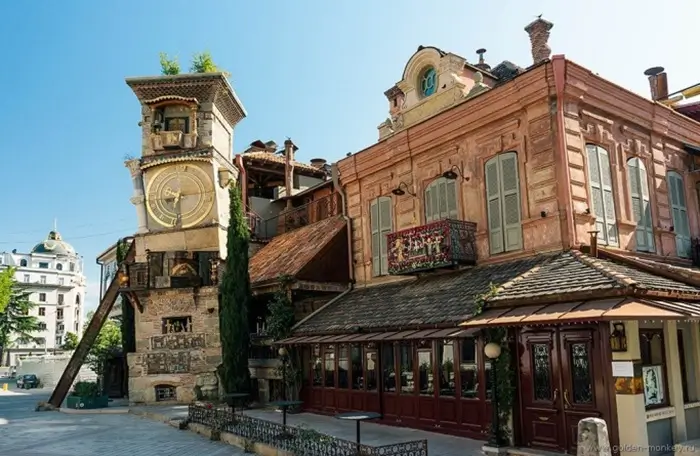
Old Town Tbilisi is the heart of Georgia’s capital and one of its most popular attractions. Located in the southeastern part of the city, it is surrounded by rocky hills and divided by the Kura River (known locally as Mtkvari). Here you’ll find Mtatsminda Mountain (meaning “Holy Mountain”), which offers stunning views of the entire city. Visitors can ascend the mountain via cable car or take the stairs for a more adventurous journey.
Old Tbilisi is renowned not only for its scenic streets but also for its rich cultural heritage. One symbol of this area is the Tbilisi TV Tower, standing at 275 meters on Mtatsminda. It’s a popular spot for photos, especially among tourists who love the atmosphere of the city's historic parts. The Pantheon of Georgia’s Notable Citizens is also located here, the final resting place for Georgia’s politicians, scholars, writers, and other prominent historical figures.
In Old Tbilisi, you can also enjoy local cuisine at cafes and restaurants serving traditional dishes. Street markets and souvenir shops add to the experience, offering an immersive look into Georgian culture and traditions.
2. Vardzia (Southern Georgia, near Turkey’s Border)
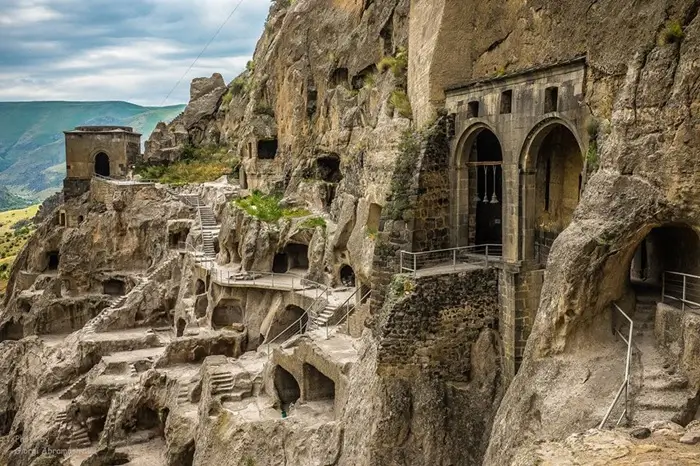
Vardzia is a unique cave city in southern Georgia, near the Turkish border. Carved into the volcanic cliffs of Mount Erusheti at 1,300 meters above sea level, this complex stretches 900 meters in length and 50 meters in depth, housing over 600 rooms, including chapels, dining halls, wine cellars, and living quarters.
Construction of Vardzia began in the 12th century under King George III and continued under his daughter, the legendary Queen Tamar. Initially designed as a fortified monastery to protect against invasions, it later became a significant cultural and religious center. Tourists can explore numerous tunnels and halls, which have retained their ancient charm, while enjoying breathtaking views of the surrounding mountains and the Kura River Valley.
Today, Vardzia is one of Georgia’s most fascinating attractions, drawing visitors with its mysterious atmosphere and cultural importance.
3. Narikala Fortress (Tbilisi)
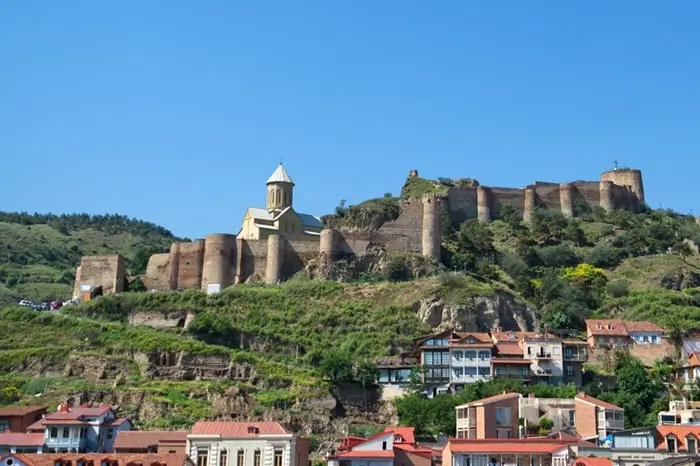
Perched atop one of Tbilisi’s hills, Narikala Fortress is one of Georgia’s most iconic landmarks. This ancient fort was built in the 4th century and has been reconstructed multiple times, playing a key role in defending the city. The name "Narikala" is associated with strength and protection, and the views from its terraces leave visitors with unforgettable impressions.
You can reach the fortress by cable car, which departs from the city center and takes visitors to the hilltop. From here, you can enjoy a stunning view of Old Tbilisi, the Kura Valley, and the surrounding hills. The fortress is particularly beautiful in the evening, when the walls and towers are illuminated, creating a mystical atmosphere.
Within the fortress is St. Nicholas Church, built in 1996 on the site of an ancient temple. This addition enhances the historical significance of the site, offering a chance to experience the spirit of ancient Georgia.
4. The Bridge of Peace (Tbilisi)
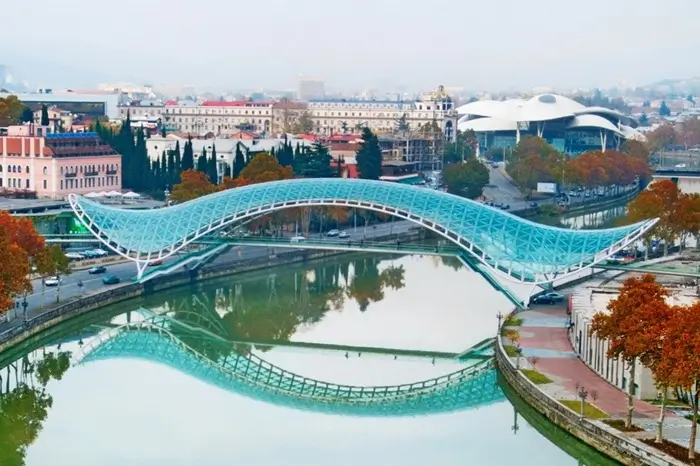
The Bridge of Peace is one of Georgia's most recognizable modern landmarks, located in central Tbilisi. This pedestrian bridge spans the Kura River, connecting the old and new parts of the city. Its architectural design is unique: the bridge's wavy glass roof resembles the Greek letter "omega." It is especially impressive in the evening when LED lighting creates a magical glow. This lighting effect was designed by Italian architect Michele De Lucchi and French designer Philippe Martinaud.
The bridge spans 150 meters in length and 5 meters in width, allowing comfortable pedestrian movement. Thousands of LED lights create dynamic light patterns, giving the bridge a futuristic appearance. The Bridge of Peace has become a symbol of unity and friendship, making it a must-visit for travelers wanting to see beautiful sights in Georgia
This bridge also symbolizes Tbilisi's architectural evolution, blending contemporary art elements with Georgian cultural identity. A stroll across the bridge leaves vivid impressions and offers wonderful views of the river and historic city streets.
5. Makhuntseti Waterfall and Queen Tamar’s Bridge (30 km from Batumi)
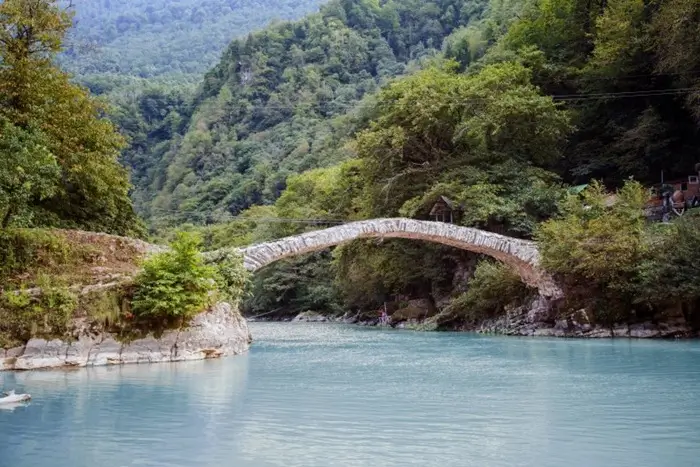
Makhuntseti Waterfall is a picturesque waterfall in Adjara, surrounded by forests and mountain views. Reaching a height of 30 meters, it’s a popular spot for tourists looking to enjoy the cool, crystal-clear water—even on hot days. The waterfall is easily accessible, with observation points offering beautiful views of the area. Nearby cafes serve refreshing drinks and snacks to visitors.
Close to the waterfall is Queen Tamar’s Bridge, one of Georgia's oldest arch bridges, built over 900 years ago. Constructed from stone and lime mortar, it remains incredibly strong and durable even by modern standards. This bridge is an important historical and cultural landmark, symbolizing the engineering mastery of medieval Georgia.
Visiting both the waterfall and the bridge allows you to immerse yourself in Georgian nature and history, enjoying the beauty of local landscapes. This area has become a popular destination for tourists looking to spend a day in nature.
6. Mtskheta (20 km from Tbilisi)
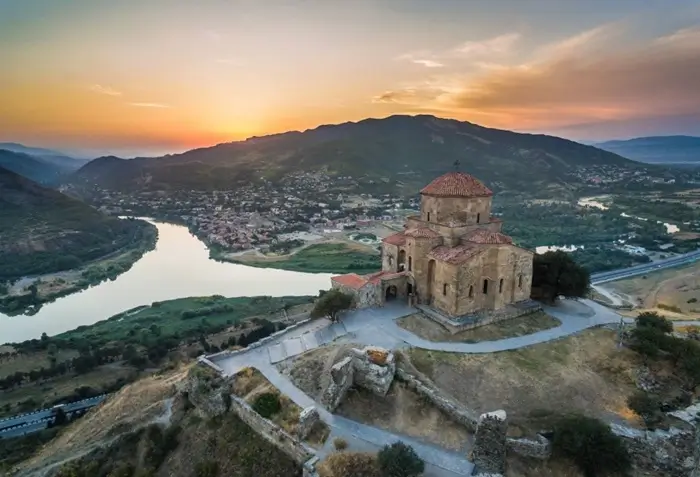
Mtskheta is an ancient city and the spiritual heart of Georgia, located only 20 kilometers from Tbilisi. A UNESCO World Heritage Site, Mtskheta is famous for its historical monuments and churches. One of its main landmarks is the Svetitskhoveli Cathedral, built in the 11th century, which is one of the oldest Christian churches in Georgia and houses sacred relics.
Mtskheta is known not only for its cathedrals but also for its picturesque streets, which have been restored and transformed into cozy pedestrian zones with cafes and souvenir shops. The city also boasts ancient archaeological sites that reflect Georgia’s rich history and culture.
Today, Mtskheta attracts numerous tourists eager to explore its cultural heritage and enjoy views of the hills and rivers surrounding the city. This small yet significant town serves as a reminder of Georgia’s ancient history and Christian traditions, making it a must-visit for those interested in the country’s beautiful sites.
7. Uplistsikhe (12 km East of Gori)
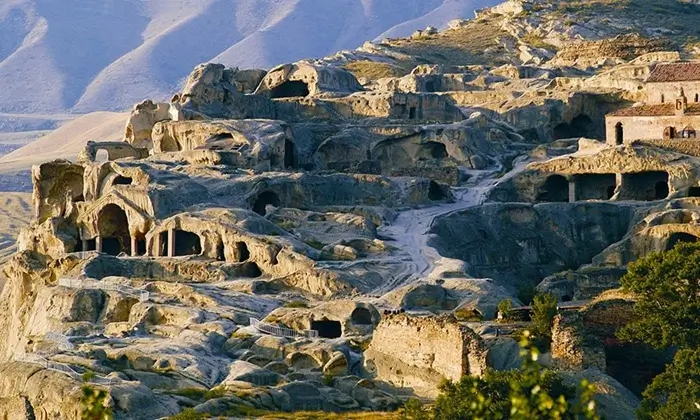
Uplistsikhe is an ancient cave city located just 12 kilometers east of Gori. This unique archaeological complex, founded over 3,000 years ago, is one of Georgia’s oldest landmarks. Carved into rock, Uplistsikhe consists of numerous rooms, including temples, granaries, storerooms, and living quarters, all connected by a network of tunnels.
Starting from the 4th century AD, Uplistsikhe gradually evolved into a cultural and religious center. Pagan rituals were held here, and the city was off-limits to Christian missionaries for a long time. Archaeological excavations have confirmed the existence of a theater, throne room, and pharmacy in Uplistsikhe, attesting to the city’s high level of civilization.
Tourists visiting Uplistsikhe can wander through the ancient tunnels and feel the atmosphere of antiquity, surrounded by magnificent landscapes. The view of the Kura River Valley and the surrounding mountains adds a unique charm to this place.
8. Mount Kazbek
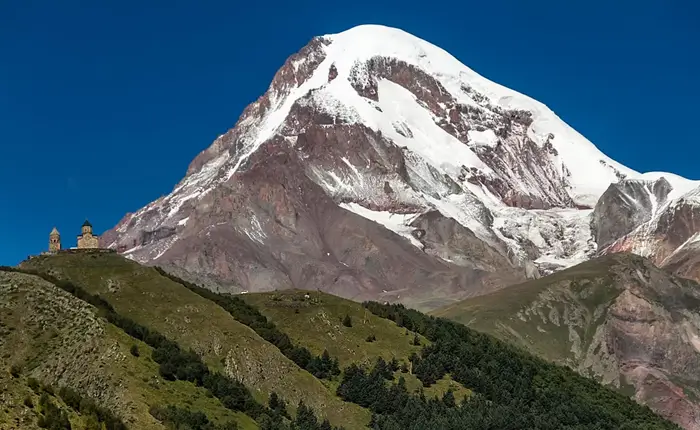
Mount Kazbek is one of the most famous mountains in the Caucasus and a symbol of outdoor adventure in Georgia. This dormant volcano, last active in the 6th century BC, now stands as a spectacular natural landmark with black-pink rocks, evidence of its ancient volcanic activity. Kazbek is located in the eastern part of the central Caucasus and is one of the popular points for mountaineering.
Climbing routes to Kazbek’s summit are challenging, making the mountain a thrilling destination for active recreation in Tbilisi and nearby areas. Glaciers begin at around 3,000 meters, feeding the Terek River and forming breathtaking views. Lush meadows and streams on the lower slopes give Kazbek a unique landscape, drawing climbers and tourists every year.
The mountain also features attractions like cave monasteries, hot springs, and the famous Gergeti Trinity Church in the village of Gergeti, built in the 14th century. This church, located at about 2,000 meters, symbolizes the spiritual strength and natural beauty of Georgia.
9. Betania Monastery (16 km from Tbilisi)
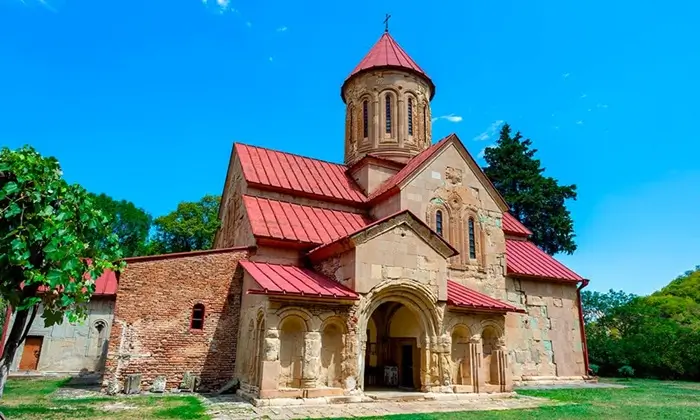
Betania Monastery, located just 16 km from Tbilisi, is a popular excursion destination. This Orthodox monastery has a rich history spanning centuries and is surrounded by picturesque, forested hills, creating an atmosphere of tranquility. According to legend, the monastery was founded by Saint Job, and its walls have witnessed many events, including invasions and natural disasters.
The architecture of Betania is notable for its simplicity and grandeur. Visitors can admire ancient frescoes painted by local artists and enjoy the harmony created by this historic building amid nature. Guided tours include visits to the main structure and scenic walks around the monastery grounds.
Betania attracts not only tourists but also pilgrims seeking spiritual peace. The monastery hosts meditation and spiritual practices, offering many a chance to connect with Georgia’s history and culture.
10. Prometheus Cave (near Tskaltubo)
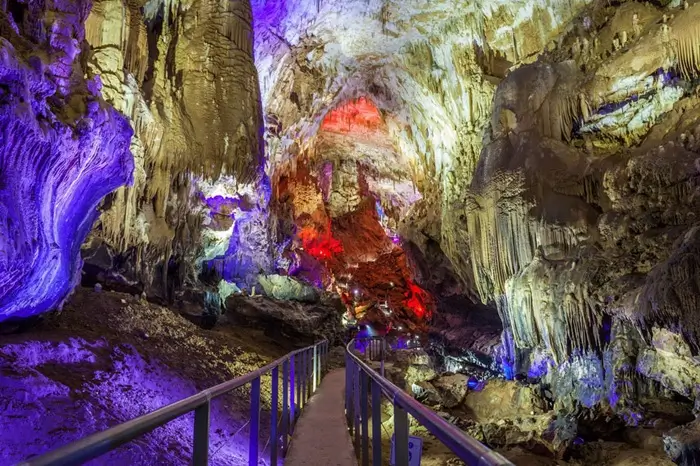
Prometheus Cave, also known as Kumistavi Cave, is located near the town of Tskaltubo and is one of the largest caves in Georgia. Discovered in 1984, it quickly became a popular tourist attraction due to its unusual formations and underground rivers. Inside, a comfortable temperature of about 14 degrees Celsius is maintained year-round, making it an ideal destination for all seasons.
Visitors can choose a 1,600-meter walking route through the cave or take an exciting boat ride along the underground river. Inside, they are treated to views of stalactites, stalagmites, and even an underground lake. The humid air and unique lighting give the cave a mystical appearance, while the play of light and shadow on the walls creates a magical atmosphere. Prometheus Cave is an ideal destination for those seeking active exploration in Tbilisi’s surroundings, especially for fans of unique natural landscapes.
11. Ananuri Fortress (12 km from Ananuri)
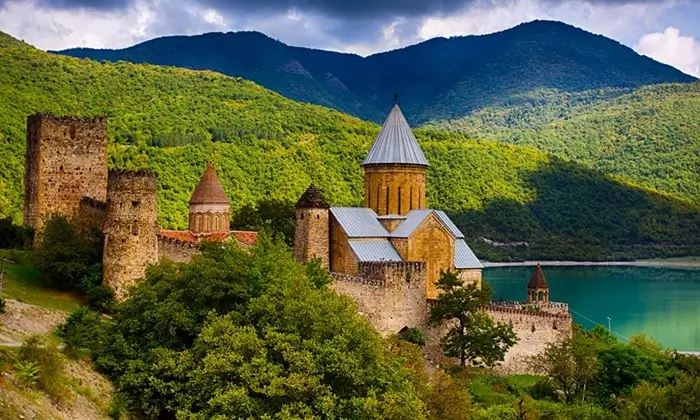
The Ananuri Fortress, located just 12 km from the town of Ananuri, is an important historical site in Georgia. Built along the banks of the Aragvi River, this complex served as a strategic defensive point for centuries and played a significant role in regional defense. Inside the fortress, you’ll find ancient towers, walls, and churches, giving it a truly unique architectural character.
The complex’s main building is the Church of the Assumption, constructed in the 17th century, showcasing a rare example of Georgian church architecture characterized by simplicity and elegance. The fortress is surrounded by high walls, from which visitors can enjoy a picturesque view of Zhinvali Reservoir and the surrounding mountains. This panorama is especially breathtaking in spring and autumn when the landscape transforms with vibrant colors.
Visiting Ananuri is a great option for history and nature lovers who want to explore tourist destinations in Georgia. The fortress has become a popular spot for photos, picnics, and for those seeking to feel the atmosphere of ancient Georgia.
12. Gergeti Trinity Church (Gergeti Village, Kazbek Foothills)
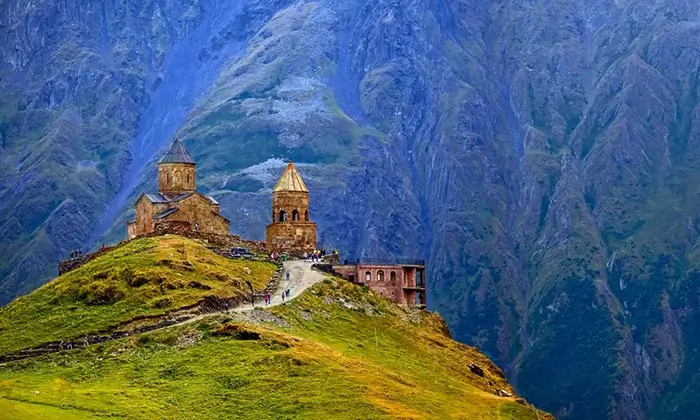
The Gergeti Trinity Church in the village of Gergeti, also known as Gergeti Church, is one of the most iconic sites in Georgia. Situated at an altitude of 2,170 meters at the base of Mount Kazbek, this 14th-century church attracts visitors with both its spiritual significance and breathtaking views of the surrounding mountains and valleys. The church can be seen from afar, seemingly floating above the clouds, which gives it a mystical atmosphere.
Built in a cross-domed architectural style, Gergeti Church is a rarity for mountainous regions in Georgia. The church served as a sanctuary for holy relics, including the Cross of Saint Nino, during invasions. Each year, thousands of pilgrims and tourists visit this unique place to witness the incredible setting. The view from the church includes Kazbek’s glaciers, the Terek River Valley, and the Caucasus Mountains.
For tourists who enjoy active exploration, the ascent to Gergeti Trinity Church offers both a challenge and an opportunity to admire the surrounding natural beauty. The church represents the strength of faith, resilience, and the spiritual heritage of the Georgian people.
13. Svan Towers (Mountain Region of Svaneti)
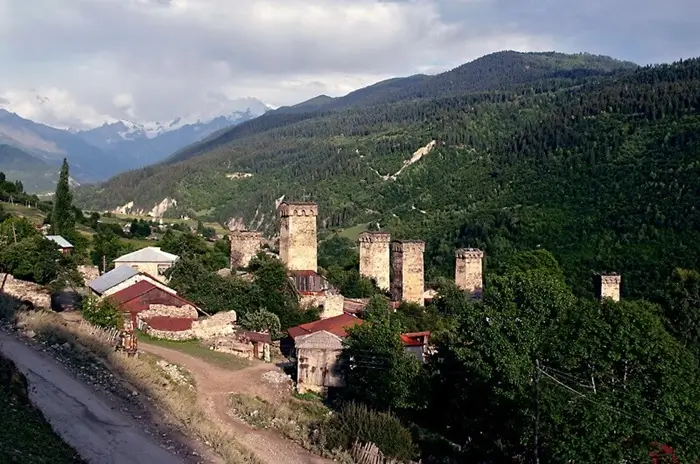
Svan Towers are unique fortifications that have become symbols of Georgia’s mountainous Svaneti region. Built between the 8th and 13th centuries, these towers served as defensive structures for locals and were used to observe incoming threats. Located in high-altitude villages like Mestia and Ushguli, these towers are a vital part of Georgia’s cultural heritage.
These rectangular towers, reaching heights of 20 to 25 meters, provided storage and refuge during attacks. Svaneti is known for its unique culture and traditions, and the towers represent the independent spirit of the Svans, who have lived for centuries in isolation among the Caucasus Mountains.
Today, Svan Towers attract tourists from around the world who want to see these architectural wonders and learn about the history and culture of the Svan people. The towers are symbols of resilience and self-defense, and Svaneti’s inclusion on the UNESCO World Heritage List highlights the uniqueness of this Georgian mountain region.
14. Dadiani Palace (Zugdidi)
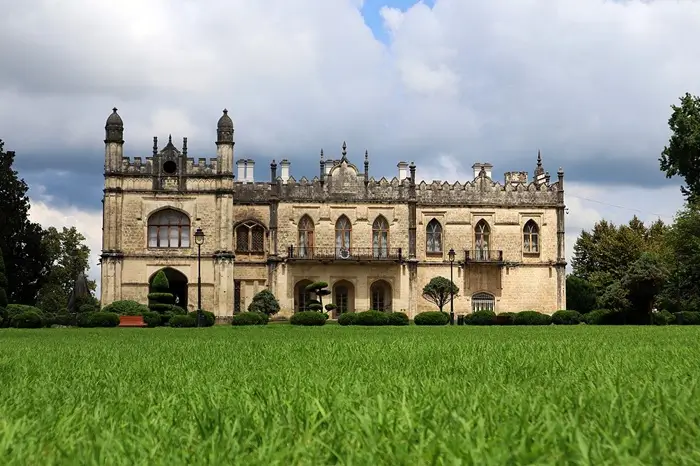
Located in Zugdidi, the Dadiani Palace is one of Georgia’s most beautiful and historically significant landmarks. Built in the 19th century, the palace served as the residence of the Dadiani princes, one of the most influential noble families in the region. Its architecture blends Georgian and European motifs, giving it a distinct appearance.
The complex includes the Royal Palace and an adjacent museum that houses unique artifacts related to the history of Georgia and the Dadiani family. Here, visitors can see rare relics, including a piece of Napoleon’s death mask and personal belongings of the Bonaparte family. A walk through the palace and its gardens allows tourists to immerse themselves in the ambiance of 19th-century Georgian aristocracy.
Surrounded by a picturesque garden with ancient trees, the palace provides a peaceful setting where tourists can enjoy views of the surrounding mountains. The Dadiani Palace has become a cultural hub in the region, attracting visitors with its history, beauty, and unique exhibits. Visiting this palace offers insight into Georgian history and the close ties between Georgia and Europe.
15. Qvevri and Wine Museum (Telavi)
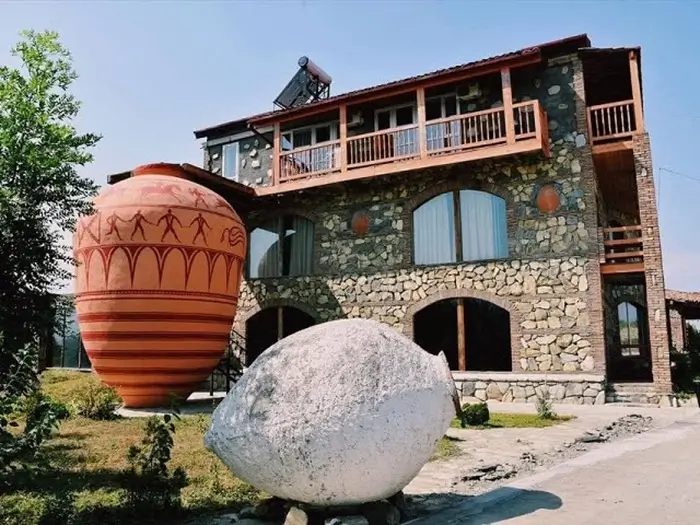
The Qvevri and Wine Museum in Telavi is dedicated to the ancient Georgian method of winemaking, which involves using large clay vessels called qvevri. This unique technique, which is over 6,000 years old, has been recognized by UNESCO as an Intangible Cultural Heritage. The qvevri are buried underground, filled with grape juice, and left to ferment, creating a rich, authentic wine with a full-bodied flavor.
The museum’s exhibits allow visitors to learn about each stage of qvevri winemaking—from grape harvesting to storage and aging. Various qvevri of different sizes are displayed, along with tools used for centuries. Special tours reveal the secrets of ancient winemaking traditions, and visitors can taste Georgian wines produced using this ancient technique.
The Qvevri Museum in Telavi has become an essential stop on the tourist route through the Kakheti region, which is famous for its vineyards and winemaking heritage. Here, visitors can not only learn about the history of wine but also participate in tastings at a wine house near the museum. This experience lets guests appreciate the unique flavors of wine crafted by ancient methods.
16. Metekhi (Tbilisi)
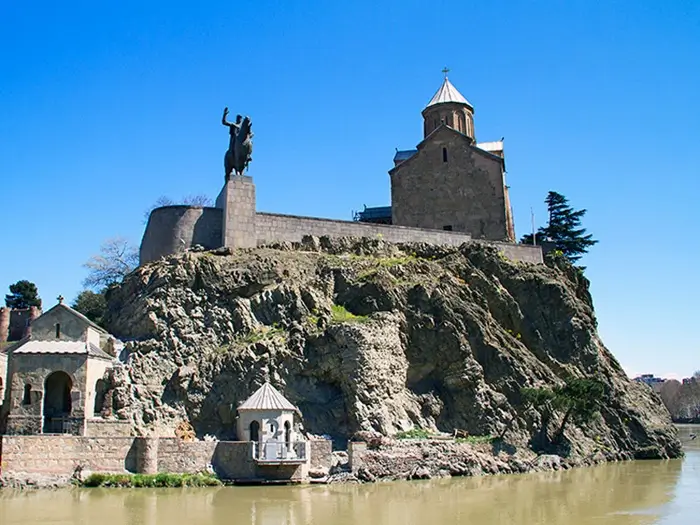
Metekhi is a historic church and fortress located on a cliff overlooking the Kura River in Tbilisi. First mentioned in the 12th century, this architectural complex has been destroyed and rebuilt multiple times throughout its history. In the past, it played a strategic role in defending the city and was surrounded by strong walls and a palace.
During the Soviet era, the church served as a prison and was later converted into a museum. Today, Metekhi once again functions as an Orthodox church and is an important spiritual center for the Georgian people. The building is decorated with carved ornaments and architectural details that reflect Georgia’s rich history. One of the walls bears an inscription dedicated to King Erekle, who rebuilt the fortress after another invasion. Metekhi attracts tourists with its unique architecture and stunning views of the old city.
17. Gelati Monastery (4 km from Kutaisi)
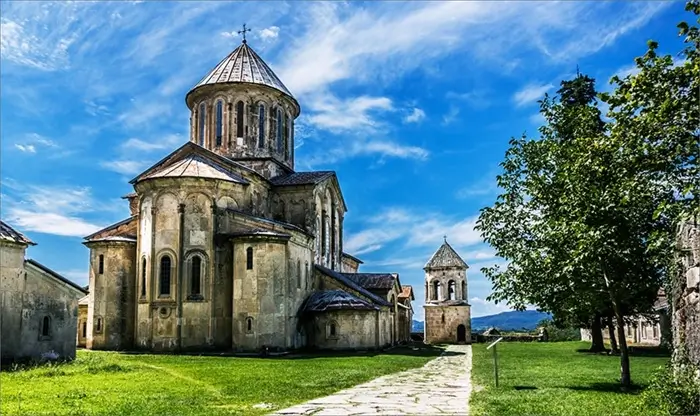
Founded in the 12th century by King David IV (David the Builder), the Gelati Monastery near Kutaisi is an important monument of Georgian culture and spirituality. This UNESCO World Heritage Site is known for its unique architecture and 12th-century frescoes. The monastery is also the burial place of several Georgian kings, including David the Builder himself.
Gelati was not only a religious center but also a center of learning in medieval Georgia. It housed an academy where theology, philosophy, and science were taught. The main church of the monastery is adorned with magnificent mosaics and frescoes in Byzantine style, representing some of the finest examples of ancient Georgian art. Today, Gelati Monastery continues to attract pilgrims and tourists who want to connect with Georgian spiritual and cultural heritage.
18. Mirza-Riza Khan's House (Borjomi)
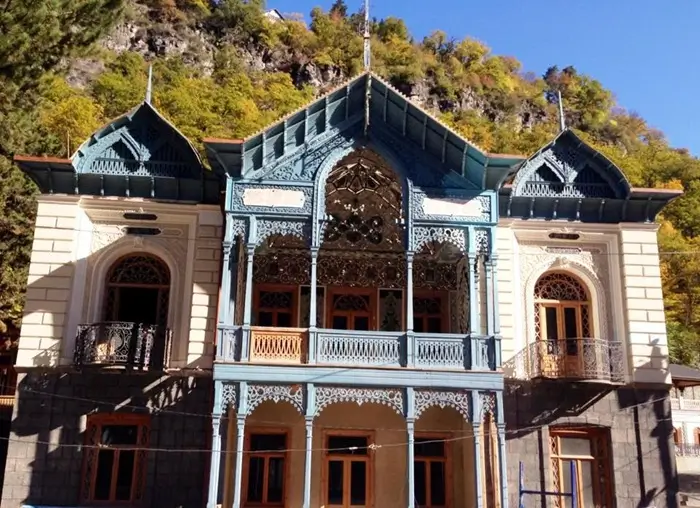
Mirza-Riza Khan’s House in Borjomi is a beautiful example of 19th-century architecture and a unique monument of Georgian heritage. Built in 1892, the house belonged to the Persian consul Mirza-Riza Khan, who used it as a summer residence. Its architecture blends Georgian and Eastern motifs, creating an impression of lightness and elegance.
The building attracts attention with its facade, decorated with intricate patterns and turquoise inlays, giving it a distinct look. The central balcony, adorned with colorful stones and mirror elements, has become one of the house’s recognizable symbols. The building was named "Firuz", meaning "turquoise," which aptly describes its color palette.
Today, Mirza-Riza Khan’s House is a popular tourist attraction in Borjomi and is protected by the state as an important historical monument. In the past, it also served as a sanatorium, and it now stands as a reminder of Borjomi’s history as a prominent resort in the Caucasus region.
19. Katskhi Pillar (Katskhi Village)
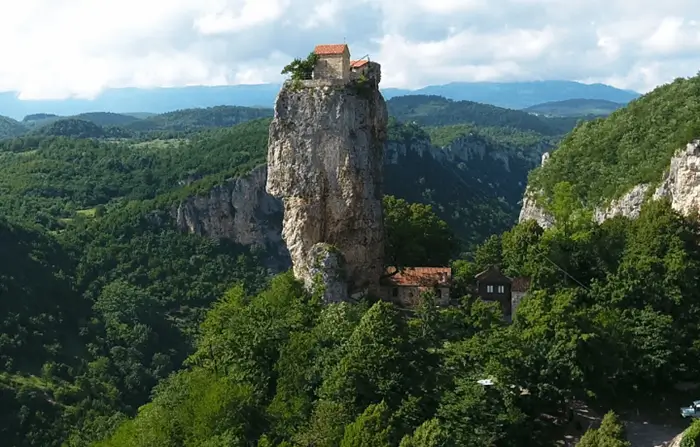
The Katskhi Pillar is one of Georgia’s unique tourist attractions, located in the Imereti region near Chiatura. This limestone monolith, approximately 40 meters high, towers above the surrounding landscape and serves as a symbol of spiritual ascent. At the top of the pillar is a small church, and locals believe this site is the closest place to heaven.
The name "Katskhi" translates to "peak," highlighting the spiritual significance of this place even before the arrival of Christianity. It was believed that heaven met earth here, making it a sanctuary of fertility. The church atop the pillar was destroyed during Ottoman invasions, and its restoration began only in the 20th century, thanks to the efforts of climbers and a monk named Maxime, who spent an entire winter there.
Today, access to the top of the pillar is restricted, and only permitted individuals can climb a special ladder, adding to the site’s mystique and seclusion. Visitors can view the church, crypt, and wine cellar on this small plateau. Due to its isolated location and religious significance, the Katskhi Pillar is often compared to the Greek Meteora monasteries.
20. Alphabet Tower (Batumi)
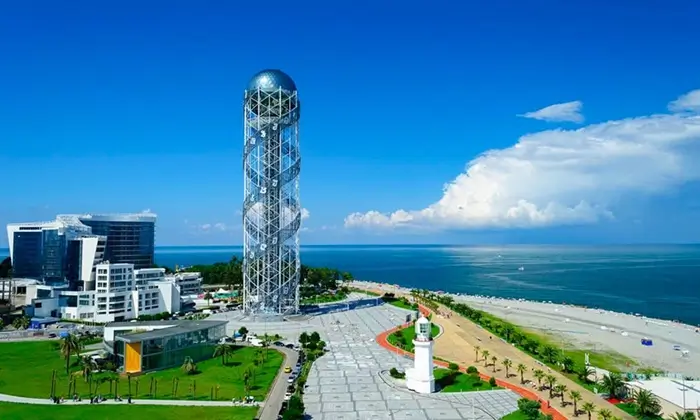
The Alphabet Tower in Batumi is a modern architectural structure dedicated to the Georgian alphabet and the country’s cultural identity. Built in 2011, the tower stands 130 meters tall and has a cylindrical shape wrapped in two spiral bands that represent the DNA structure. Georgian alphabet letters, made of aluminum, are displayed on these bands, symbolizing the uniqueness and ancient origin of the Georgian script.
Features of Alphabet Tower:
- Observation Deck – Located inside the tower, it provides stunning views of the city, the Black Sea, and the surrounding mountains.
- Glass Sphere – Visitors can ascend to a glass sphere at the top of the building.
- Panoramic Restaurant – The restaurant slowly rotates, offering a 360-degree view without guests having to leave their seats.
- Illumination – In the evening, the tower is illuminated with LED lights, and the alphabet letters glow, making it a striking feature of Batumi’s night skyline.
The Alphabet Tower has become an essential part of Batumi’s landscape, drawing tourists with its innovative design. It represents Georgia’s cultural revival and its aspirations toward modernity while preserving national traditions.
Tourist Destinations in Georgia: Final Thoughts
Georgia is a unique country that combines historical and natural attractions with opportunities for active recreation. Sights in Georgia draw tourists with their ancient fortresses, towering mountains, monasteries, bridges, and nature reserves. Every corner of Georgia offers something remarkable: from the atmospheric streets of Old Tbilisi with its magnificent Narikala Fortress to ancient cave cities like Vardzia and Uplistsikhe.
But Georgia appeals not only to those interested in history and architecture but also to adventure seekers. Paragliding over the picturesque mountains lets you feel part of these stunning landscapes and enjoy panoramic views from above. Rafting down fast-flowing mountain rivers promises unforgettable emotions and allows visitors to test their skills on turbulent rapids. Zip-lining over lush forests and deep gorges offers an adrenaline rush and a feeling of complete unity with nature.
Such activities make a holiday in Georgia truly diverse and suitable for travelers with all kinds of interests. Whether you prefer leisurely strolls through historic towns or engaging in active sports, Georgia has the power to amaze everyone.









